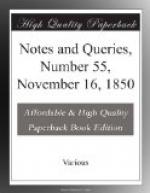“Anglais=angles; Oui
des grans=Ovides grans; Virgiles=Aigles;
d’Angela=dangels; sont=font;
A ja=N’a pas; buvraige=ouvrage;
rafrener=rafrecir; soif=soix;
Qui men=Qu’en ma; En=Et.”
After such an exhibition of various readings, arising out of only two copies of the same manuscript, it is evident that a re-collation of it is very desirable, and I am sure the result would be thankfully received by the numerous admirers of Chaucer.
BOLTON CORNEY.
Eustache Deschamps (Vol. ii., p. 376.).—J.M.B. is desirous of learning some particulars of this French poet, contemporaneous with Chaucer. He will find a brief notice of him in the Recueil de Chants Historiques Francais, depuis le XIIeme jusqu’au XVIIIeme Siecle, by Le Roux de Lincy (2 vols. Paris, 1841, Libraire de Charles Espelin). He is there described as,
“Ecuyer et huissier
d’armes des rois Charles V. et Charles VI., qui
resta toujours fidele a la
maison de France;”
And the editor adds:
“Les oeuvres d’Eustache Deschamps contiennent pour l’histoire du XIVeme siecle des renseignemens precieux; on peut y recueillir des faits politiques qui ne sont pas sans importance, mais on y trouve en plus grand nombre des details precieux sur les moeurs, les usages, et les coutumes de cette epoque.”
His poems were published for the first time in one vol. 8vo., in 1832, by M. Crapelet, with this title: {404}
“Poesies morales et
historiques d’Eustache Deschamps, ecuyer, huissier
d’armes des rois Charles
V. et Charles VI., chatelain de Fismes et
bailli de Senlis.”
As regards the “genuineness” of the poem cited, I am inclined, with J.M.B., to think that it admits of question, the orthography savouring more of the end of the fifteenth than of the close of the fourteenth century. I am sorry not to be able to explain the meaning of “la langue Pandras.”
D.C.
* * * * *
NOTES ON THE SECOND EDITION OF MR. CUNNINGHAM’S HANDBOOK OF LONDON.
21. New Tunbridge Wells, at Islington.—This fashionable morning lounge of the nobility and gentry during the early part of the eighteenth century, is omitted by Mr. Cunningham. There is a capital view of it in Bickham’s Musical Entertainer, 1737:
“These once beautiful tea-gardens (we remember them as such) were formerly in high repute. In 1733 their Royal Highnesses the Princesses Amelia and Caroline frequented them in the summer time for the purpose of drinking the waters. They have furnished a subject for pamphlets, poems, plays, songs, and medical treatises, by Ned Ward, George Colman the older, Bickham, Dr. Hugh Smith, &c. Nothing now remains of them but the original chalybeate spring, which is still preserved in an obscure nook, amidst a poverty-stricken and squalid rookery of misery




